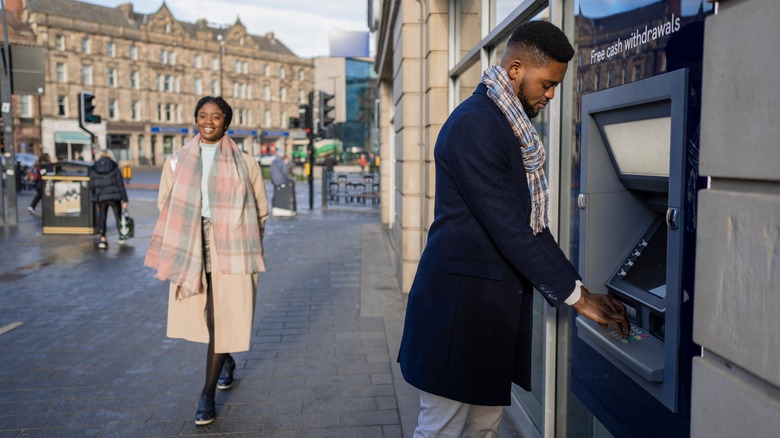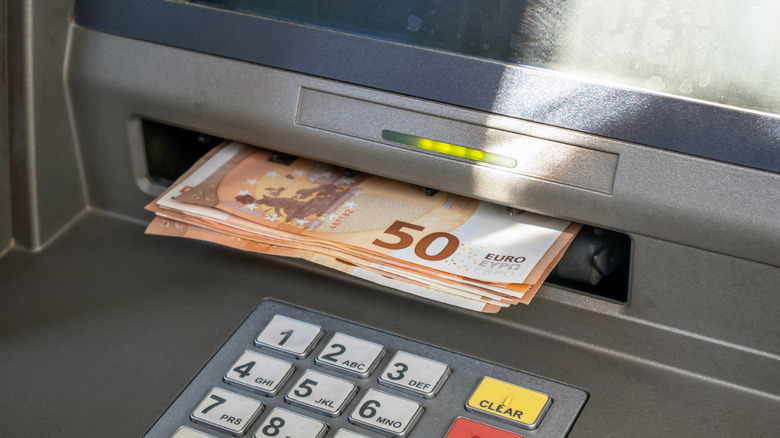The Money-Wasting ATM Mistake Too Many Tourists Make On A Trip To Europe
Deciding to travel to Europe opens the door to adventures of a lifetime, from exploring the ancient ruins of Italy to the age-old mountains of Spain and beyond. However, excitement can often get the better of tourists, especially when they encounter a seemingly minor decision at the ATM that can lead to unnecessary expenses: accepting the dynamic currency conversion (DCC) rate offered by ATMs and card machines. Though it appears convenient, this choice is a trap that will add up significantly throughout a trip.
You might be asking, what in Hermes' name (the Greek god of wealth) is dynamic currency conversion? Simply put, dynamic currency conversion is a service that enables tourists to use a credit or debit card to pay for transactions in their home currency instead of the local currency of the country they are visiting. While this might seem helpful at first glance — since the ATM displays the transaction cost in your home currency, eliminating the need to calculate conversion rates — you are losing money.
When you withdraw money from an ATM in Europe and choose to go ahead with the transaction in your home currency, you're accepting the financial institution offering the DCC to add a hefty markup to the standard exchange rate, sometimes as high as 5% to 10%, to cover the "convenience" of converting the amounts for your bank. This rate is almost always worse than what your home bank would charge if the transaction were conducted in the local currency.
ATM currency conversion: the cost implications
The extra charges might not seem like much on a one-time transaction — say if you have run out of cash toward the end of your trip — but if the adventure has just begun or you expect multiple withdrawals ahead, your travel spending will inflate significantly. For example, if a tourist withdraws 300 euros at an ATM, a 7% higher rate means paying an extra $21 based on a typical exchange rate of 1 euro to $1.08. Multiply that by several withdrawals over a two-week vacation, and the additional costs can run into the hundreds of dollars — money that could otherwise enhance the travel experience through meals, souvenirs, or even an extra night in your favorite, relaxed European town.
The key to avoiding these unnecessary fees is simple: always choose to be charged in the local currency. Understandably, some people might feel overwhelmed when using an ATM abroad. To avoid confusion and ensure you're making the right choice, remember this simple guideline during your travels: "Local = yes, home = no." Easy, right? Mind you, this applies not just to ATM withdrawals but also to card payments in restaurants, shops, and hotels. When the card terminal or ATM asks whether to charge you in your home or local currency, the process is the same. This way, your home bank will handle the conversion, and you don't have to worry about the sneaky DCC fees offered by the local ATM or merchant. Every dollar counts!
How to manage your money while traveling in Europe
Europe can be expensive, and without careful money management, you might frequently search for the nearest ATM to settle bills. To avoid this, ensure your cards function correctly in Europe so you won't need to withdraw extra emergency cash. Before departing, inform your bank of travel plans to prevent unexpected security holds on your cards due to foreign transactions.
Understanding your bank's fees for foreign transactions and ATM withdrawals is essential. These range from 1% to 5%, but 3% is the most common. Some banks offer special accounts with reduced or waived fees, which can be beneficial if you travel frequently. For larger purchases, consider a credit card that provides favorable foreign exchange rates and no transaction fees. This leads to significant savings as credit card companies, too, can stack on their own international fees. Companies like Visa, Mastercard, Capital One, and American Express offer good options, depending on your needs.
Despite the widespread acceptance of cards in Europe, carrying local cash is always more effective for staying within your spending limits. This is particularly beneficial for small purchases in markets or rural areas where cards may not be accepted. Just remember, when using a foreign ATM, think "local = yes, home = no" to the DCC. This will help you have a more enjoyable European trip with cash to spare! And if you really want to protect your money when using an ATM, Rick Steves has some more helpful tips.


